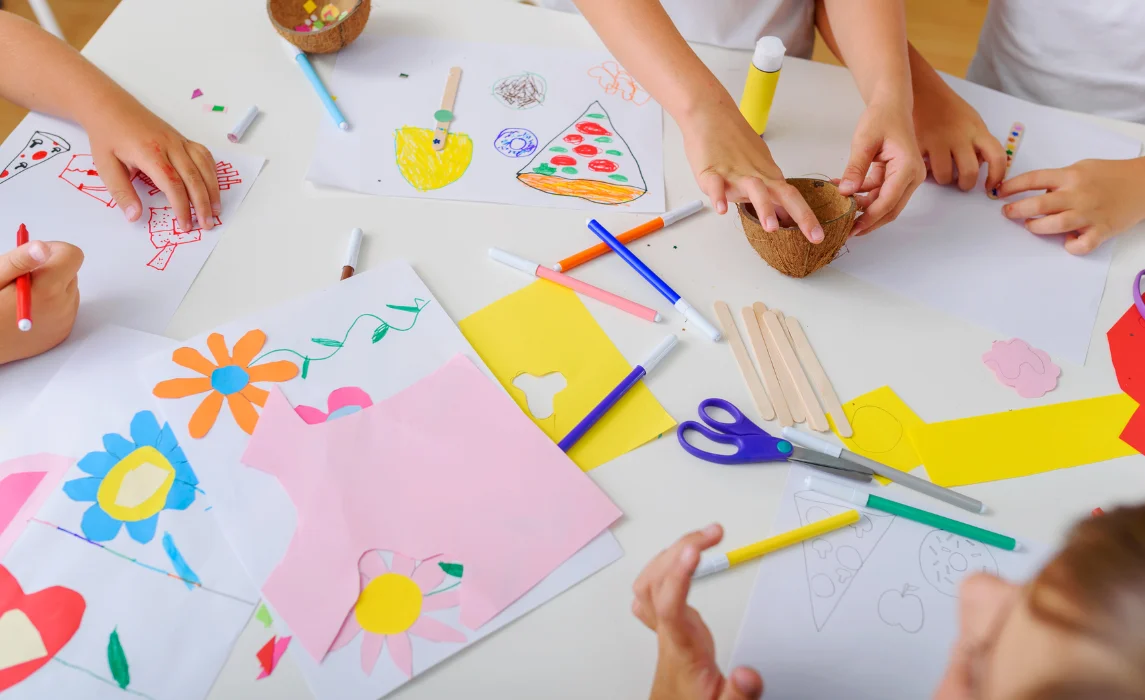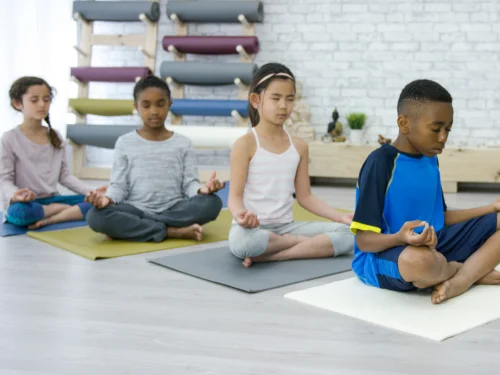Brain Breaks for Kids: 60+ Easy Ideas to Reset Focus (for Home & Classroom)

Yes—finger plays, clapping games, and dance routines that use hand gestures all help. Combine rhythm and repetition for deeper learning.
Send home simple activity ideas, kits, or worksheets. Offer short instructions and encourage family involvement. Regular practice builds lasting progress.
Try origami, sticker scenes, stringing pasta, or painting with Q-tips. Crafts that use small pieces build precision and control.
Brain breaks are short, planned pauses that help kids rest and recharge their brains during learning or homework time. When children focus for long periods, their brains get tired, and their bodies crave movement. A brain break gives them a quick mental reset—through motion, breathing, or play—so they can return to learning with better focus and mood.
These breaks usually last 3–5 minutes and can be done right at a desk or in a small area. They don’t require fancy tools—just a bit of creativity and fun!
Why Brain Breaks Work (Simple Science for Big Results)
.webp)
Kids learn best when their minds and bodies work together. When they move, their heart rate and oxygen levels increase, which improves memory, alertness, and motivation. Calm or mindful activities reduce stress and help children regulate emotions.
Even a short 3-minute change of pace can make it easier for kids to concentrate, solve problems, and stay positive.
Main benefits of brain breaks:
- Boost attention and focus
- Reduce frustration and burnout
- Improve mood and self-control
- Support physical and emotional well-being
- Make transitions smoother and more enjoyable
How Often Should Kids Take Brain Breaks?
.webp)
The best time for a brain break is every 15–25 minutes of focused work.
Younger children or those doing demanding tasks may need breaks more often.
Keep each break short—3 to 5 minutes is ideal—to refresh focus without losing momentum.
Use a timer or a fun signal (like a bell, clap, or song) so kids know when breaks begin and end.
If energy is dropping, start a break early; if kids are on a roll, finish the task first.
How to Choose the Right Brain Break
.webp)
Not all breaks serve the same purpose.
The key is to match the activity to the child’s energy level:
- Restless or fidgety? Try a movement break to release energy.
- Tired or overwhelmed? Pick a calming or mindful break.
- Bored or distracted? Use a sensory or skill-based break to re-engage thinking.
Keeping a variety of options makes it easier to pick the right kind of reset every time.
Movement Brain Breaks (Energy Boosters)
Movement breaks wake up the body and the brain. They help release energy, build coordination, and make transitions back to work smoother.
- Freeze Dance – Play upbeat music and have kids dance. When the music stops, they freeze in place.
- Chair Aerobics – March, stretch, and swing your arms while sitting down.
- Balloon Keep-Up – Use a balloon (or crumpled paper ball) and keep it in the air as long as possible.
- Animal Walks – Move like different animals: crawl like a bear, hop like a frog, or waddle like a penguin.
- Wall Push-Ups – Stand facing a wall and do ten gentle push-ups to build strength.
- Invisible Jump Rope – Pretend to jump rope in place for 30 seconds.
- Simon Says (Move!) – Follow commands only when Simon says—great for listening and impulse control.
- Red-Light, Green-Light – Walk or run in place, stopping when the “light” turns red.
- Rocket Launch – Squat down low and jump high like a rocket blasting off.
- Follow the Leader – One child leads creative moves while others copy.
Calming and Mindful Brain Breaks
Calming breaks help children slow down, manage stress, and refocus. They’re perfect for transitions after high-energy activities or when kids feel frustrated.
- Five-Finger Breathing – Trace each finger while breathing in and out slowly.
- Star Breathing – Draw a star in the air: breathe in as you move up, breathe out as you move down.
- Hot Hands – Rub hands together to warm them, then place them gently over closed eyes.
- Chime Listening – Ring a bell or tap a glass. Kids listen quietly until the sound fades.
- Cat-Cow Stretch – On hands and knees, arch the back like a cat and then stretch like a cow.
- Seated Twist – Sit tall and gently twist side to side to release tension.
- Slow-Motion Wings – Lift arms slowly with an inhale, lower them with an exhale.
- Jellyfish Float – Pretend to float softly underwater with slow, flowing arm motions.
- Gratitude Pause – Name three small things you’re thankful for today.
- Mini Meditation – Close eyes, breathe deeply, and imagine a calm, happy place.
Sensory Brain Breaks
Sensory breaks help kids reset through touch, sound, or movement. They’re especially helpful for children who feel overstimulated or under-alert.
- Fresh-Air Minute – Step outside or open a window; notice what you hear and smell.
- Texture Hunt – Find one item that’s smooth, one rough, one soft, and one hard.
- Playdough or Paper Squish – Roll and press playdough, or crumple and flatten scrap paper.
- Desk Drumming – Tap rhythms on your desk and copy your partner’s beat.
- Scavenger Sprint – In 60 seconds, find three blue objects in the room.
- Balance Walk – Walk heel-to-toe across a taped line on the floor.
- Hand Tracing – Trace your hand on paper, focusing on slow, steady lines.
Skill-Building Brain Breaks
Skill-based breaks give the brain a new challenge while still offering rest from structured work. They’re short, creative, and often funny!
- Riddle of the Day – Ask a simple riddle and let everyone guess.
- Mini Puzzle – Work on one small part of a jigsaw puzzle.
- Alphabet Categories – Name foods, animals, or sports for each letter.
- Secret Handshake – Invent a fun handshake pattern with a partner.
- Story Starter – Begin with a sentence like “Once, a tiny robot found…” and add details.
- Math Dice – Roll two dice and add, subtract, or multiply the numbers.
- Word Builder – Choose a long word and see how many smaller words you can make from it.
- Tongue Twisters – Say funny phrases like “Red lorry, yellow lorry” three times fast.
- Quick Memory Game – Show kids five small objects, hide one, and ask what’s missing.
- Draw and Guess – One person draws while others guess what it is.
Quick Game Brain Breaks
Short games are perfect for refreshing focus and bringing a smile to everyone’s face. They can be done anywhere with no cleanup.
- Heads Up (No Tech) – Act out clues while your partner guesses.
- Charades – Take turns acting out animals, movies, or jobs.
- Four Corners – Everyone chooses a corner; the leader calls one out, and those kids sit.
- Silent Ball – Toss a ball quietly; drop it or talk and you’re out!
- I Spy – “I spy something that starts with the letter B…”
- Minute-to-Win-It Challenge – Stack cups or balance objects for 60 seconds.
- Guess the Sound – Play or make mystery sounds for others to identify.
- Alphabet Hunt – Find one object for each letter of the alphabet.
Classic Brain Breaks That Never Get Old
These traditional games have lasted for decades for a reason—they’re easy, engaging, and always fun.
- Clap-Back Pattern – Copy a rhythm the leader claps.
- Call-and-Response – Teacher says, “Ready, set…” kids answer, “Focus!”
- Make It Rain – Tap fingers, then hands, to sound like a rainstorm, then reverse.
- Xs and Os – Curl into a small ball (O), then stretch arms and legs wide (X).
- The Wave – Stand in a line and lift arms one by one like a stadium wave.
- Balance Statue – Hold a pose like a statue for 10 seconds without moving.
- Face Gymnastics – Wiggle eyebrows, make fish faces, or giant smiles.
- Skip-Count Rap – Clap while counting by 2s, 5s, or 10s.
- Mirror Me – Copy your partner’s tiny movements silently.
- Silent Cheer – Celebrate success with big, silent motions.
How to Make Brain Breaks Work Every Time
.webp)
- Set a Rhythm: Try a pattern like 20 minutes work + 3 minutes break.
- Use Timers: Visible timers help kids know when the break will end.
- Give Choices: Let kids pick from a “Brain Break Jar” or chart.
- Stay Consistent: Use the same few activities daily for smoother transitions.
- End Calmly: Use a signal like “Ready bodies, ready minds” to refocus.
Tip: Allow one child to be the “Break Leader” each day—it builds responsibility and makes participation exciting.
You May Also Like: 15 Mindfulness Activities for Kids: Simple Ways to Build Calm, Focus, and Emotional Strength
Sample Daily Brain Break Plan
.webp)
Morning: Movement – Freeze Dance (3 min)
Late Morning: Calming – Five-Finger Breathing (2 min)
After Lunch: Sensory – Balance Walk (3 min)
Mid-Afternoon: Skill-Building – Riddle of the Day (3 min)
A few short, planned breaks like this can make a big difference in focus and cooperation all day.
You May Also Like: 10+ Sight Word Activities: Fun and Effective Ways to Build Reading Confidence
FAQs About Brain Breaks
1. Are brain breaks only for young kids?
No. Older kids and even adults benefit from short breaks. The activities may be calmer or more skill-based, but the reset effect is the same.
2. Won’t breaks waste learning time?
Actually, they save time. Kids work more efficiently afterward and need fewer reminders to focus.
3. How many breaks should I plan in a day?
Aim for 3–6 short breaks, depending on age, schedule, and activity level.
4. What if kids get too silly?
Set expectations early: stay safe, stay in your spot, and follow the timer. A clear start and end cue helps maintain structure.
5. What if one child needs a break sooner?
Offer quick solo options like deep breathing, stretching, or a one-minute “quiet zone.”
You May Also Like: Communication Skills for Kids: How to Help Your Child Communicate Better




